Phase Reversal Method for Damage Imaging in Composite Laminates Based on Data Fusion
Abstract
:1. Introduction
2. Materials and Methods
2.1. Phase-Reversal Method
2.2. Data Fusion
3. Results
3.1. Numerical Analysis Results
3.2. Experimental Results
4. Conclusions
Author Contributions
Funding
Institutional Review Board Statement
Informed Consent Statement
Data Availability Statement
Acknowledgments
Conflicts of Interest
References
- Dávila, C.G.; Bisagni, C. Fatigue life and damage tolerance of postbuckled composite stiffened structures with initial delamination. Compos. Struct. 2017, 161, 73–84. [Google Scholar] [CrossRef]
- Farrar, C.R.; Worden, K. An introduction to structural health monitoring. Philos. Trans. Math. Phys. Eng. Sci. 2007, 365, 303–315. [Google Scholar] [CrossRef]
- Tian, Z.; Yu, L.; Leckey, C. Delamination detection and quantification on laminated composite structures with lamb waves and wavenumber analysis. J. Intell. Mater. Syst. Struct. 2015, 26, 1723–1738. [Google Scholar] [CrossRef]
- Feng, K.; Li, Z. Damage Imaging in Composite Laminates Using. AIP Conf. Proc. 2019, 2102, 15–19. [Google Scholar]
- Loutas, T.H.; Charlaftis, P.; Airoldi, A.; Bettini, P.; Koimtzoglou, C.; Kostopoulos, V. Reliability of strain monitoring of composite structures via the use of optical fiber ribbon tapes for structural health monitoring purposes. Compos. Struct. 2015, 134, 762–771. [Google Scholar] [CrossRef]
- Cho, Y. Estimation of ultrasonic guided wave mode conversion in a plate with thickness variation. IEEE Trans. Ultrason. Ferroelectr. Freq. CControl 2000, 47, 591–603. [Google Scholar]
- Schaal, C.; Mal, A. Lamb wave propagation in a plate with step discontinuities. Wave Motion 2016, 66, 177–189. [Google Scholar] [CrossRef]
- Raghavan, C.; Cesnik, C.E.S. Review of guided-wave structural health monitoring. Shock. Vib. Digest. 2007, 39, 91–114. [Google Scholar] [CrossRef]
- Takiuti, B. Wave Scattering From Discontinuities Related to Corrosion-Like Damage in One-Dimensional Waveguides. J. Soc. Mech. Sci. Eng. 2020, 42, 521. [Google Scholar] [CrossRef]
- Xu, B.; Giurgiutiu, V. Single mode tuning effects on Lamb wave time reversal with piezoelectric wafer active sensors for structural health monitoring. J. Nondestruct. Eval. 2007, 26, 123–134. [Google Scholar] [CrossRef] [Green Version]
- Watkins, R.; Jha, R. A modified time reversal method for Lamb wave based diagnostics of composite structures. Mech. Syst. Signal Processing 2012, 31, 345–354. [Google Scholar] [CrossRef]
- Kannusamy, M.; Kapuria, S.; Sasmal, S. Accurate baseline-free damage localization in plates using refined Lamb wave time-reversal method. Smart Mater. Struct. 2020, R1, 109608. [Google Scholar] [CrossRef]
- Hua, J.; Gao, F.; Zeng, L.; Lin, J. Modified sparse reconstruction imaging of lamb waves for damage quantittative evaluation. NDT E Int. 2019, 107, 102143. [Google Scholar] [CrossRef]
- Qiu, L.; Liu, B.; Yuan, S.; Su, Z.; Ren, Y. A scanning spatial-wavenumber filter and pzt 2-d cruciform array based on-line damage imaging method of composite structure. Sens. Actuators A Phys. 2016, 248, 62–72. [Google Scholar] [CrossRef]
- Cawley, P.; Alleyne, D. The use of lamb waves for the long range inspection of large structures. Ultrasonics 1996, 34, 287–290. [Google Scholar] [CrossRef]
- Ruzzene, M. Frequency-wavenumber domain filtering for improved damage visualization. Smart Mater. Struct. 2007, 16, 1556–1563. [Google Scholar] [CrossRef] [Green Version]
- Liu, L.; Yuan, F.G. A linear mapping technique for dispersion removal of lamb waves. Struct. Health Monit. 2010, 9, 75–86. [Google Scholar] [CrossRef]
- Luo, Z.; Zeng, L.; Lin, J.; Hua, J. A reshaped excitation regenerating and mapping method for waveform correction in lamb waves dispersion compensation. Smart Mater. Struct. 2016, 26, 025016. [Google Scholar] [CrossRef] [Green Version]
- Xu, B.; Yu, L.; Giurgiutiu, V. Lamb wave dispersion compensation in piezoelectric wafer active sensor phased-array applications. Int. Soc. Opt. Eng. 2009, 7295, 729516. [Google Scholar]
- Kessler, S.S.; Spearing, S.M.; Soutis, C. Damage detection in composite materials using lamb wave methods. Smart Mater. Struct. 2002, 11, 269–278. [Google Scholar] [CrossRef] [Green Version]
- Liu, Y.; Li, Z.; Gong, K.Z.; Su, X.Y. A quantitative damage identification method for cf/ep composite laminates based on lamb waves. Appl. Mech. Mater. 2011, 83, 13–18. [Google Scholar] [CrossRef]
- Liu, Z.H.; Xu, Y.Z.; He, C.F.; Wu, B. Experimental study on defect imaging based on single Lamb wave mode in plate-like structures. Eng. Mech. 2014, 31, 232–238. (In Chinese) [Google Scholar]


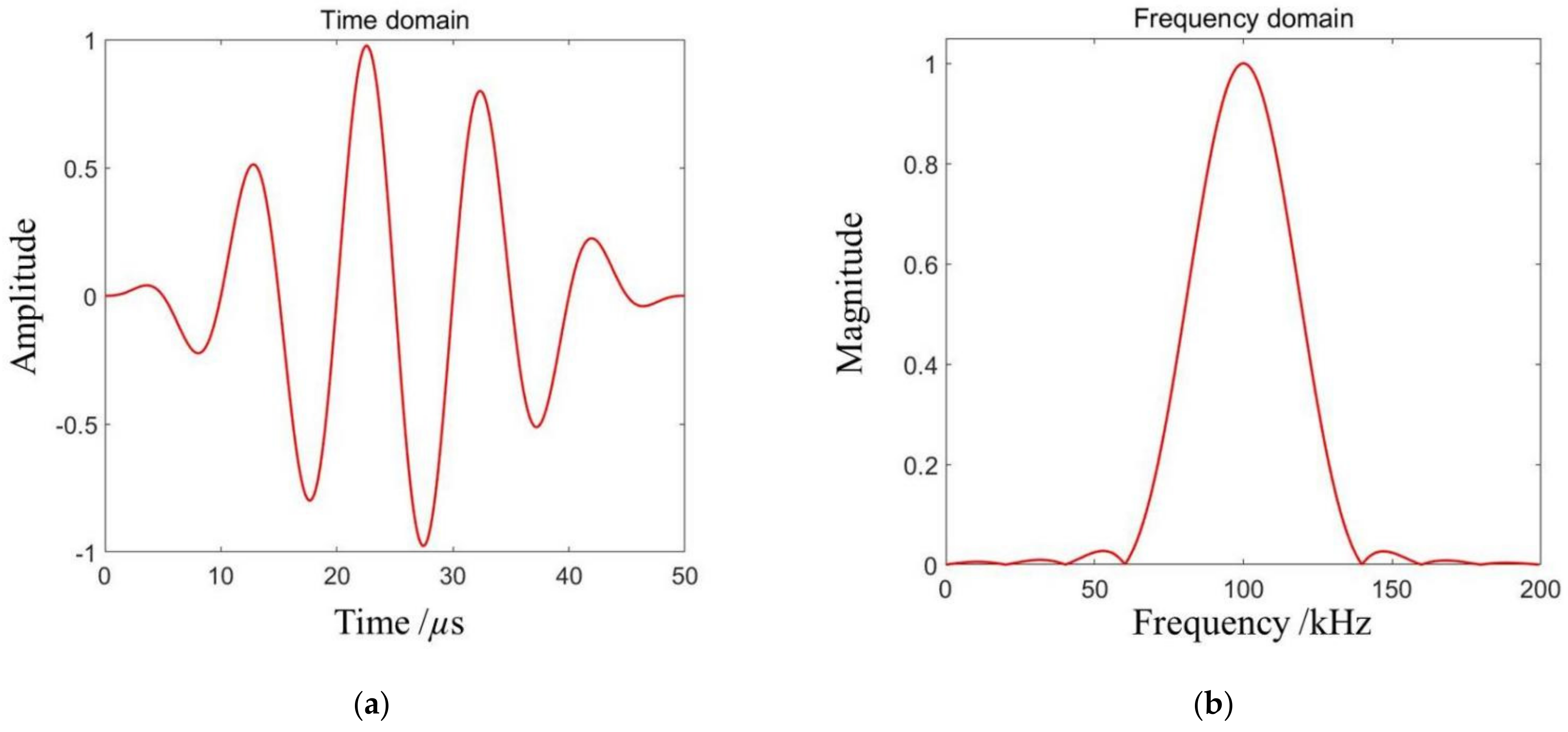

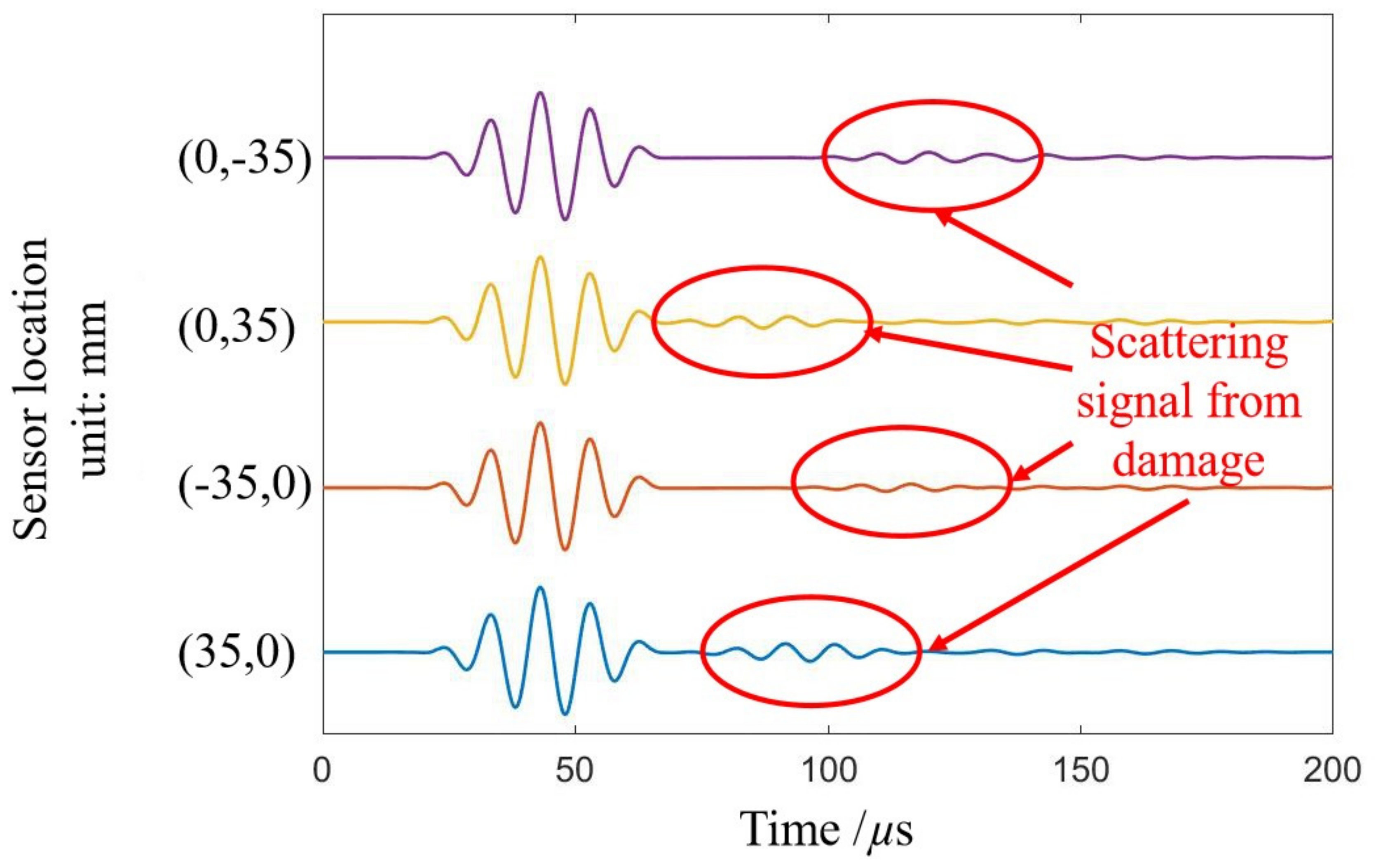

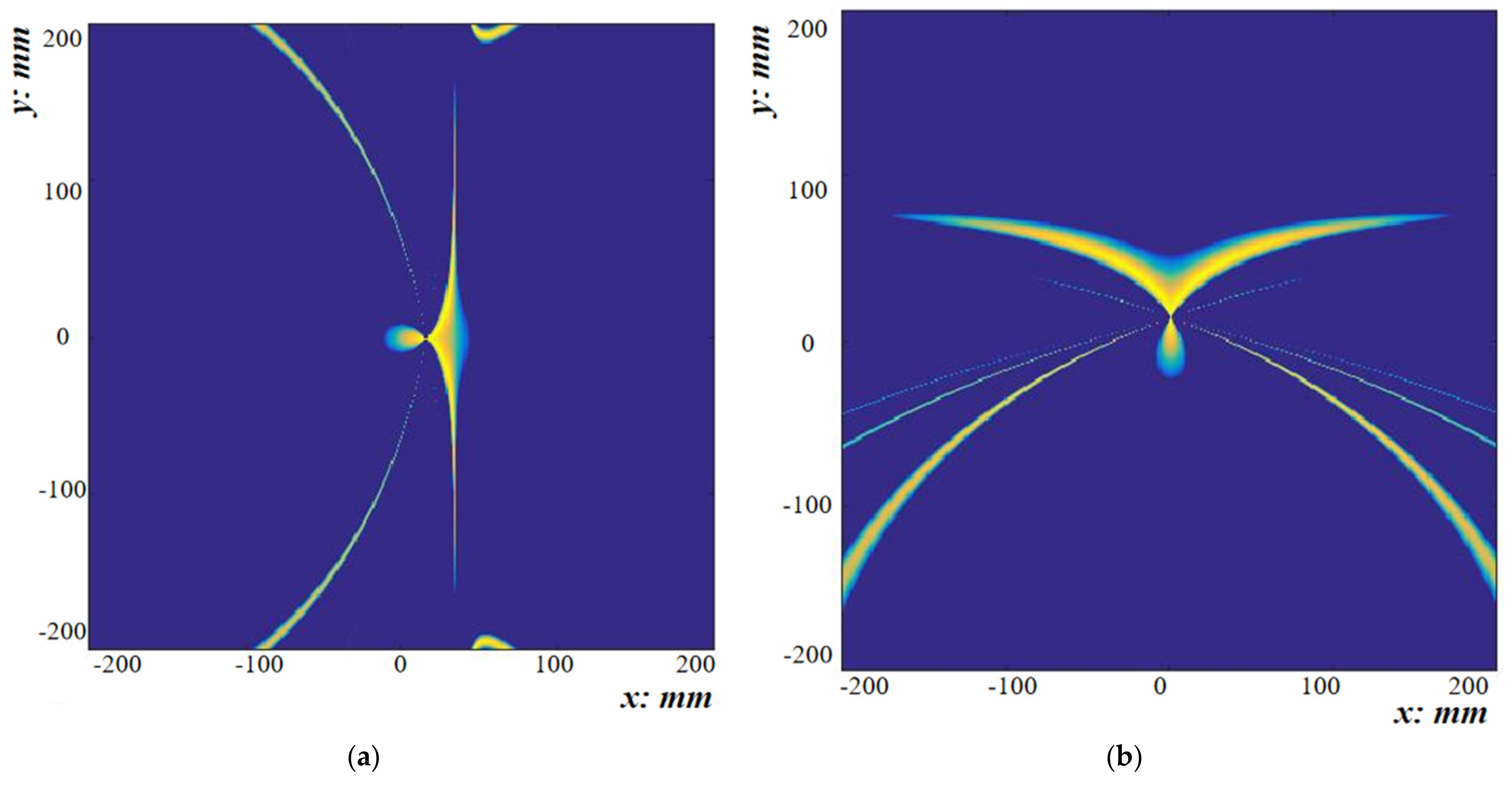
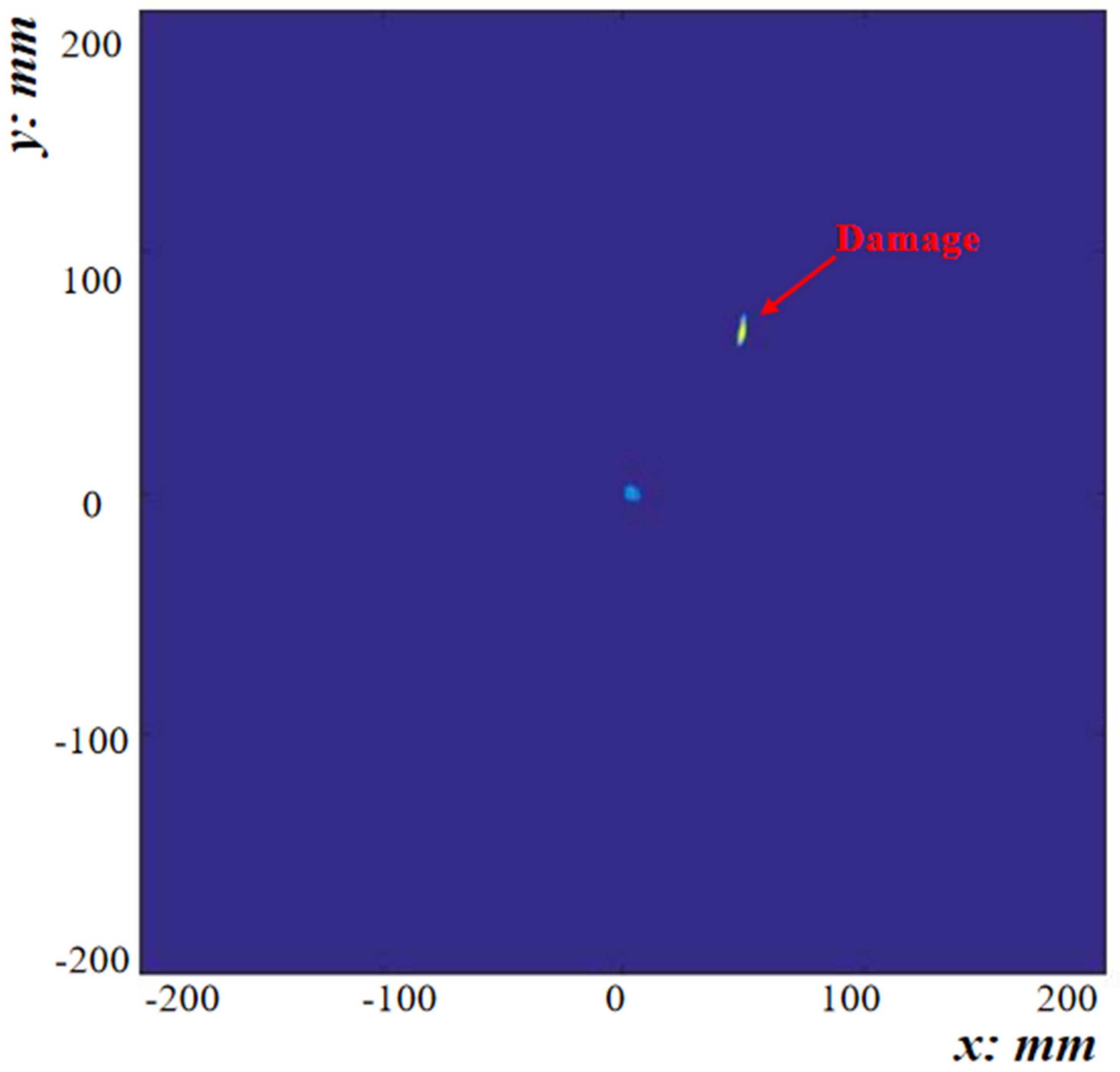
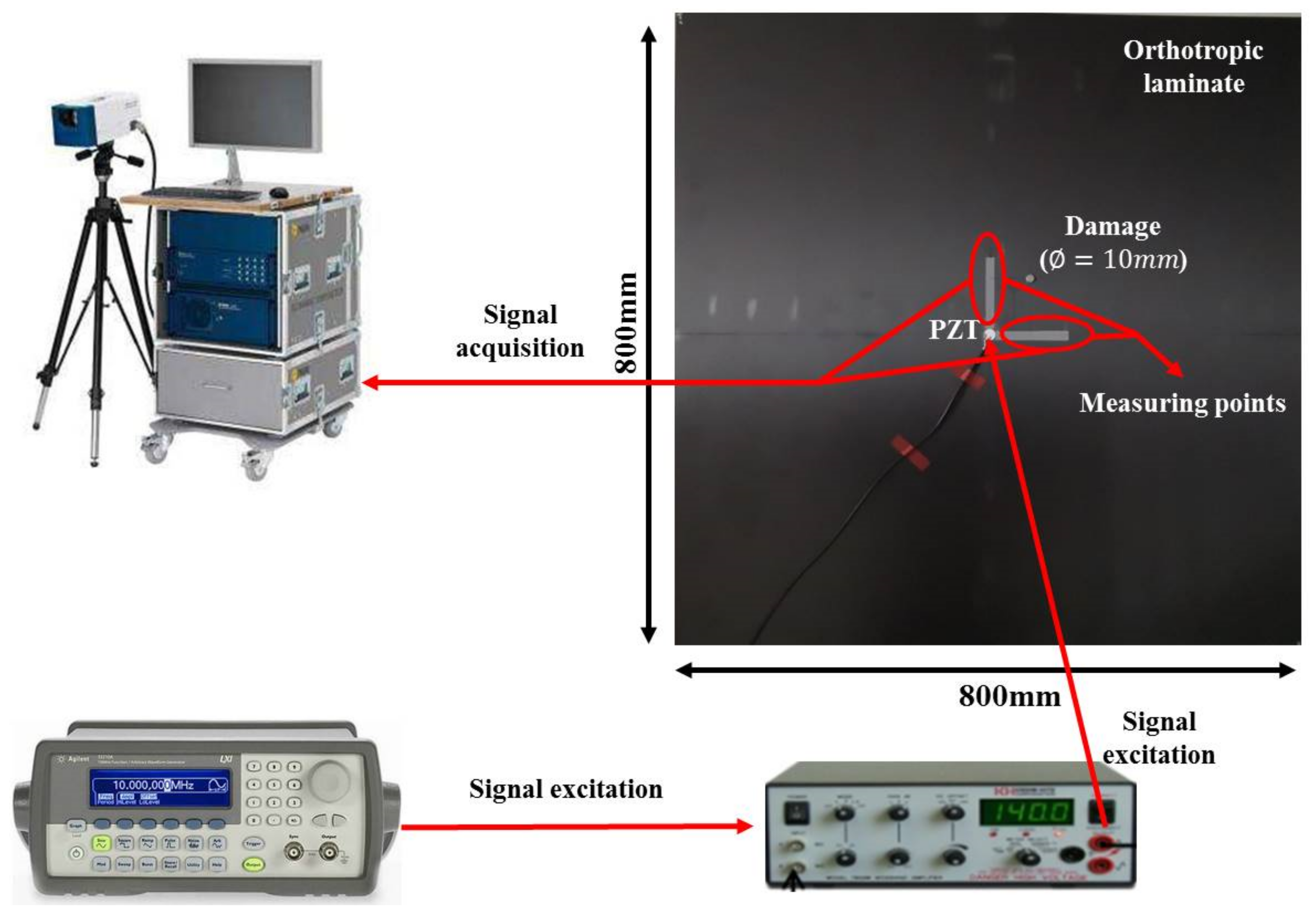
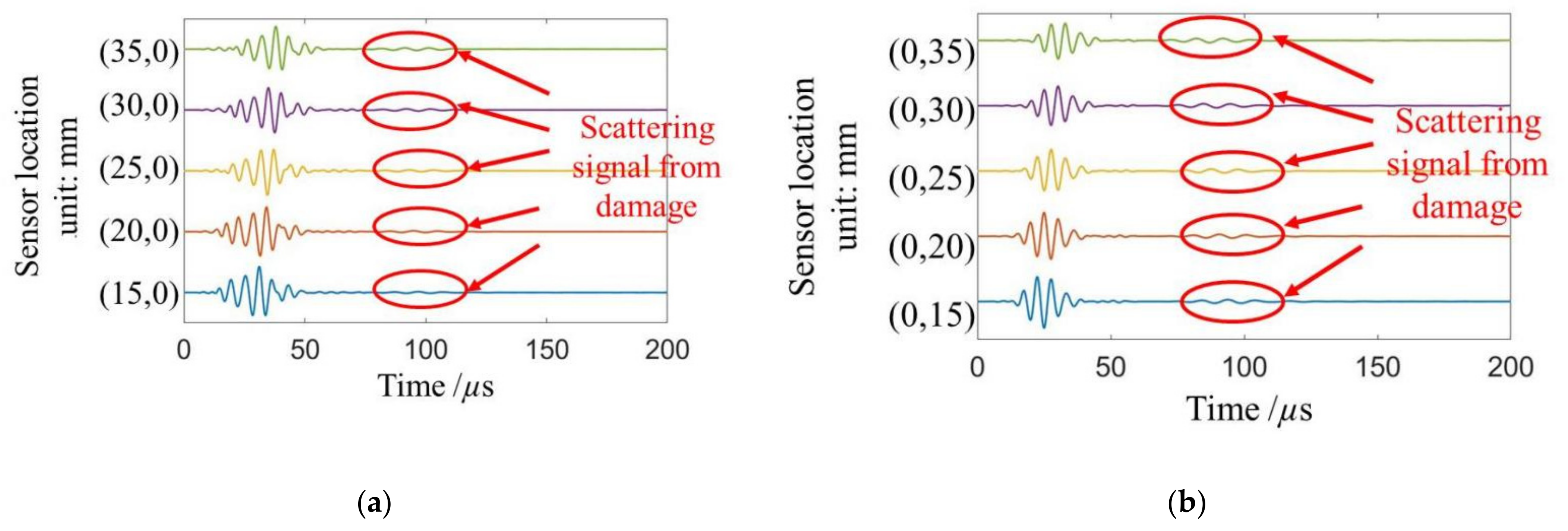

| Thickness | E11 | E22 | G12 | G23 | v12 | v23 |
|---|---|---|---|---|---|---|
| 1 mm | 178 GPa | 178 GPa | 5.2 GPa | 5.2 GPa | 0.34 | 0.34 |
| x-Axis (Positive) | x-Axis (Negative) | y-Axis (Positive) | y-Axis (Negative) | |
|---|---|---|---|---|
| Sensor location | 15–35 mm | (−15)–(−35) mm | 15–35 mm | (−15)–(−35) mm |
| Number of sensors | 21 | 21 | 21 | 21 |
| x-Axis (Positive) | y-Axis (Positive) | |
|---|---|---|
| Sensor location | 15–35 mm | 15–35 mm |
| Number of sensors | 21 | 21 |
Publisher’s Note: MDPI stays neutral with regard to jurisdictional claims in published maps and institutional affiliations. |
© 2022 by the authors. Licensee MDPI, Basel, Switzerland. This article is an open access article distributed under the terms and conditions of the Creative Commons Attribution (CC BY) license (https://creativecommons.org/licenses/by/4.0/).
Share and Cite
Han, W.; Feng, K.; Yang, H. Phase Reversal Method for Damage Imaging in Composite Laminates Based on Data Fusion. Appl. Sci. 2022, 12, 2894. https://doi.org/10.3390/app12062894
Han W, Feng K, Yang H. Phase Reversal Method for Damage Imaging in Composite Laminates Based on Data Fusion. Applied Sciences. 2022; 12(6):2894. https://doi.org/10.3390/app12062894
Chicago/Turabian StyleHan, Wei, Kan Feng, and Huagen Yang. 2022. "Phase Reversal Method for Damage Imaging in Composite Laminates Based on Data Fusion" Applied Sciences 12, no. 6: 2894. https://doi.org/10.3390/app12062894






